 W
WThe lesser adjutant is a large wading bird in the stork family Ciconiidae. Like other members of its genus, it has a bare neck and head. It is however more closely associated with wetland habitats where it is solitary and is less likely to scavenge than the related greater adjutant. It is a widespread species found from India through Southeast Asia to Java.
 W
WThe brown-capped babbler is a member of the family Pellorneidae.
 W
WThe dark-fronted babbler is an Old World babbler found in the Western Ghats of India and the forests of Sri Lanka. They are small chestnut brown birds with a dark black cap, a whitish underside and pale yellow iris. They forage in flocks in the undergrowth of forests constantly making calls and uttering alarm calls when disturbed.
 W
WThe tawny-bellied babbler also known in older Indian works as the rufous-bellied babbler is a small babbler that forages in groups in low scrub forests. Like other members of the large Old World babbler family they are passerine birds characterised by soft fluffy plumage. Foraging in small groups that skulk inside bushes there are three subspecies within the Indian Subcontinent. The nominate hyperythra found in northern and eastern India is uniformly brown underneath while albogularis of the western Indian peninsula is white throated. The population in Sri Lanka, phillipsi, is also white throated but is paler underneath and has a larger bill.
 W
WThe yellow-billed babbler is a member of the family Leiothrichidae endemic to southern India and Sri Lanka. The yellow-billed babbler is a common resident breeding bird in Sri Lanka and southern India. Its habitat is scrub, cultivation and garden land. This species, like most babblers, is not migratory, and has short rounded wings and a weak flight and is usually seen calling and foraging in groups. It is often mistaken for the jungle babbler, whose range overlaps in parts of southern India, although it has a distinctive call and tends to be found in more vegetated habitats. Its name is also confused with T. leucocephala, which is also known as white-headed babbler.
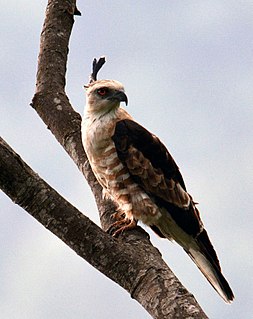 W
WJerdon's baza is a moderate sized brown hawk with a thin white-tipped black crest usually held erect. It is found in South-east Asia. It inhabits foothills in the terai and is rarer in evergreen forests and tea estates.
 W
WThe chestnut-headed bee-eater, or bay-headed bee-eater, is a near passerine bird in the bee-eater family Meropidae. It is a resident breeder in the Indian subcontinent and adjoining regions, ranging from India east to Southeast Asia.
 W
WThe yellow-browed bulbul, or golden-browed bulbul, is a species of songbird in the bulbul family, Pycnonotidae. It is found in the forests of southern India and Sri Lanka. The yellow-browed bulbul is mainly yellow on the underside and olive above with a distinct yellow brow. They are easily located by their loud calls but tend to skulk within foliage below the forest canopy. While its taxonomic classification has changed over time, it is currently the sole species within the monotypic genus Acritillas which is closely related to Hemixos.
 W
WThe square-tailed drongo-cuckoo is a species of cuckoo that resembles a black drongo. It is found in Sri Lanka and Southeast Asia and is a summer visitor to the Himalayas from Kashmir to eastern Bangladesh. The calls are series of piercing sharp whistles rising in pitch but shrill and choppily delivered.
 W
WThe white-bellied drongo is a species of drongo found across the Indian Subcontinent. Like other members of the family Dicruridae, they are insectivorous and mainly black in colour, but with a white belly and vent. Young birds are, however, all black and may be confused with the black drongo, which is smaller and more compact in appearance. The subspecies found in Sri Lanka has white restricted to the vent.
 W
WThe spot-bellied eagle-owl, also known as the forest eagle-owl is a large bird of prey with a formidable appearance. It is a forest-inhabiting species found in the Indian Subcontinent and Southeast Asia. This species is considered part of a superspecies with the barred eagle-owl, which looks quite similar but is allopatric in distribution, replacing the larger spot-bellied species in the southern end of the Malay Peninsula and the larger island in Southeast Asia extending down to Borneo.
 W
WThe rufous-bellied eagle or rufous-bellied hawk-eagle is a bird of prey in the family Accipitridae that is found in the forested regions of tropical Asia. Relatively small for eagles and contrastingly patterned like a falcon, this species was earlier placed in the genus Hieraaetus and sometimes also in the genus Aquila but thought to be distinctive enough to belong to a separate genus.
 W
WThe crimson-backed flameback or greater Sri Lanka flameback is a species of bird in the woodpecker family Picidae that is endemic to Sri Lanka.
 W
WThe pale-billed flowerpecker or Tickell's flowerpecker is a tiny bird that feeds on nectar and berries, found in India, Sri Lanka, Bangladesh and western Myanmar. The bird is common especially in urban gardens with berry bearing trees. They have a rapid chipping call and the pinkish curved beak separates it from other species in the region.
 W
WThe painted francolin or painted partridge is a species of francolin found in grassy areas in central and southern India and in the lowlands of southeastern Sri Lanka. They are easily detected by their loud calls especially during the breeding season. Thomas C. Jerdon noted that the species was found mainly in Central India south of the Narmada and to the east of the Western Ghats as well as the Chota Nagpur and Northern Circars. It can be confused only with the black francolin with which it partly overlaps and is said to sometimes hybridize. This species can be told apart from the female of a black francolin by the lack of a rufous hind collar and the white spots on the underside. The face is rufous and there is no dark stripe running behind the eye.
 W
WThe Sri Lanka frogmouth, Sri Lankan frogmouth or Ceylon frogmouth is a small frogmouth found in the Western Ghats of south India and Sri Lanka. Related to the nightjars, it is nocturnal and is found in forest habitats. The plumage coloration resembles that of dried leaves and the bird roosts quietly on branches, making it difficult to see. Each has a favourite roost that it uses regularly unless disturbed. It has a distinctive call that is usually heard at dawn and dusk. The sexes differ slightly in plumage.
 W
WLegge's hawk-eagle is a bird of prey. Like all eagles, it is in the family Accipitridae. It breeds in the Indian subcontinent, from southern India to Sri Lanka. Its specific name kelaarti honors the physician-zoologist E.F. Kelaart.
 W
WThe Malabar pied hornbill, also known as lesser pied hornbill, is a bird in the hornbill family, a family of tropical near-passerine birds found in the Old World.
 W
WThe black-headed ibis, also known as the Oriental white ibis, Indian white ibis, and black-necked ibis, is a species of wading bird of the ibis family Threskiornithidae which breeds in the South- and Southeast Asia from India to the west and as far east as Japan. It is the only native ibis species in its range that has an overall white plumage with a black neck and head. The down-curved beak and legs are also black. Though often referred to as a wetland species, the black-headed ibis forages in a range of natural and man-made habitats. This species of ibis nests only during the rainy season.
 W
WThe Indian blackbird is a member of the thrush family Turdidae. It was formerly considered a subspecies of the common blackbird. It is found only in India and Sri Lanka. The subspecies from most of the Indian subcontinent, simillimus, nigropileus, bourdilloni and spencei, are small, only 19–20 centimetres long, and have broad eye-rings. They also differ in proportions, wing formula, egg colour and voice from the common blackbird.
 W
WThe Indian swiftlet, or Indian edible-nest swiftlet, is a small swift. It is a common resident colonial breeder in the hills of Sri Lanka and south west India.
 W
WMarshall's iora, also known as the white-tailed iora, is a songbird in the genus Aegithina found in parts of India and Sri Lanka.
 W
WThe blue-eared kingfisher is found in Asia, ranging across the Indian subcontinent and Southeast Asia. It is found mainly in dense shaded forests where it hunts in small streams. It is darker crowned, with darker rufous underparts and lacking the rufous ear stripe of the common kingfisher which is found in more open habitats. A number of subspecies have been described that differ in measurement and colour shade. Adult males have an all dark bill while females have a reddish lower mandible.
 W
WThe stork-billed kingfisher, is a tree kingfisher which is widely but sparsely distributed in the tropical Indian subcontinent and Southeast Asia, from India to Indonesia. This kingfisher is resident throughout its range.
 W
WJerdon's bush lark or Jerdon's lark is a species of lark in the family Alaudidae found in south Asia. This was formerly considered as a subspecies of Mirafra assamica and termed as the Madras bushlark. Two other species in the complex include Mirafra marionae and Mirafra microptera. Jerdon's bush lark is typically very pale on the underside
 W
WJerdon's leafbird is a species of leafbird found in forest and woodland in India and Sri Lanka. Its name honours Thomas C. Jerdon. It has traditionally been considered a subspecies of the blue-winged leafbird, but differ in measurements and morphology, it lacking the blue flight feathers for which the blue-winged leafbird was named.
 W
WThe Legge's flowerpecker or white-throated flowerpecker is a small passerine bird. It is an endemic resident breeder in Sri Lanka. It is named after the Australian ornithologist William Vincent Legge.
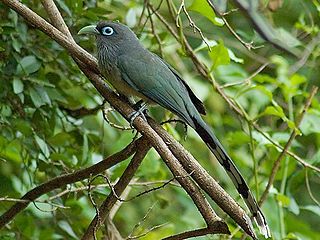 W
WThe blue-faced malkoha or small green-billed malkoha, is a non-parasitic cuckoo found in the scrub and deciduous forests of peninsular India and Sri Lanka. It has a waxy, dark, blue-grey plumage on its upperparts and has a long tail with graduated white-tipped feathers. The throat and chin are dark with spiny pale feathers that are branched. The lower belly is a dull creamy to rufous colour. The bill is apple green, and a naked patch of blue skin surrounds the eye. The sexes are alike. The blue-faced malkoha is a bird of open forests and scrub jungle.
 W
WThe orange minivet is a species of bird in the cuckooshrike family, Campephagidae. It is found in Sri Lanka and the western coast of India. Its natural habitats are temperate forests, subtropical or tropical moist lowland forest, and subtropical or tropical moist montane forest. It was formerly considered a subspecies of the scarlet minivet.
 W
WThe tricoloured munia is an estrildid finch, native to Bangladesh, India, Sri Lanka, and southern China. The species was also introduced to Trinidad, Jamaica, Hispaniola, Puerto Rico, Cuba, and Venezuela. This species, like the chestnut munia has been known as the black-headed munia. Immature birds have pale brown upperparts, lack the dark head found in adults, and have uniform buff underparts that can be confused with immatures of other munias such as the scaly-breasted munia.
 W
WThe black-throated munia or Jerdon's mannikin is a small passerine bird. This estrildid finch is a resident breeding bird in the hills of southwest India, the Eastern Ghats and Sri Lanka.
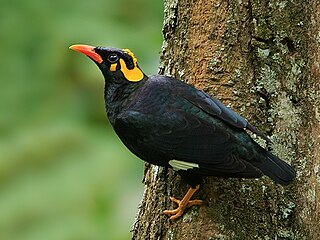 W
WThe southern hill myna is a member of the starling family. It is a resident of southwestern India and Sri Lanka.
 W
WThe brown-backed needletail, or brown needletail, is a large swift.
 W
WJerdon's nightjar is a medium-sized nightjar species which is found in southern India and Sri Lanka. Formerly considered as a subspecies of the long-tailed nightjar it is best recognized by its distinctive call which sounds like a wooden plank being beaten periodically with each note ending in a quaver. The common name commemorates the surgeon-naturalist Thomas C. Jerdon who described the species and it was called the Ghat nightjar in older literature.
 W
WThe jungle nightjar is a species of nightjar found in Bangladesh, India, and Sri Lanka. It is found mainly on the edge of forests where it is seen or heard at dusk. The taxonomy of this and related nightjars is complex and a range of treatments have been followed that cover this and several other nightjars in the Asian region. It was formerly called the grey nightjar or Indian jungle nightjar and sometimes included the East Asian grey nightjar as a subspecies.
 W
WThe orange-billed babbler also known as Ceylon rufous babbler or Sri Lankan rufous babbler is a member of the family Leiothrichidae.
 W
WThe Sri Lanka bay owl is a species of bay owl in the family Tytonidae. It is endemic to the island of Sri Lanka and the Western Ghats in Kerala, South Western India. It was considered a subspecies of the Oriental bay owl but is now treated as a full species due to its distinctive call, plumage and disjunct distribution.
 W
WLayard's parakeet is a parrot which is a resident endemic breeder in Sri Lanka. The common name of this bird commemorates the British naturalist Edgar Leopold Layard; his first wife, Barbara Anne Calthrop, whom he married in 1845, is commemorated in the specific epithet.
 W
WThe orange-breasted green pigeon is a pigeon found across tropical Asia south of the Himalaya across parts of the Indian Subcontinent and Southeast Asia. Like other green pigeons, it feeds mainly on small fruit. They may be found in pairs or in small flocks, foraging quietly and moving slowly on trees. The nape is blue-grey and the crown is yellowish green. The uppertail coverts are bronzed and the undertail coverts are unmarked rufous. The male has a pinkish band on the upper breast with a broader orange one below while the female has a bright yellow breast.
 W
WThe Sri Lanka wood pigeon is a pigeon which is an endemic resident breeding bird in the mountains of Sri Lanka.
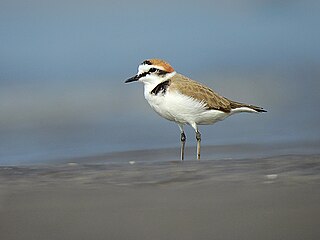 W
WThe Kentish plover is a small cosmopolitan shorebird of the family Charadriidae that breeds on the shores of saline lakes, lagoons, and coasts, populating sand dunes, marshes, semi-arid desert, and tundra. Both male and female birds have pale plumages with a white underside, grey/brown back, dark legs and a dark bill, however additionally the male birds also exhibit very dark incomplete breast bands, and dark markings either side of their head, therefore the Kentish plover is regarded as sexually dimorphic
 W
WThe jungle prinia is a small passerine bird, a warbler in the family Cisticolidae.
 W
WThe jungle bush quail is a species of quail found in the Indian subcontinent, ranging across India, Nepal, Bangladesh, Pakistan and Sri Lanka.
 W
WThe Serendib scops owl is the most recently discovered bird of Sri Lanka. It was originally located by its unfamiliar poo-ooo call in the Kitulgala rainforest by prominent Sri Lankan ornithologist Deepal Warakagoda. Six years later, it was finally seen by him on 23 January 2001 in Sinharaja, and formally described as a species new to science in 2004. Apart from Sinharaja and Kitulgala, it has also been found at Runakanda Reserve in Morapitiya and Eratna Gilimale. Known as පඩුවන් බස්සා in Sinhala.
 W
WThe Sri Lanka thrush or Sri Lanka scaly thrush is a member of the thrush family Turdidae. This bird is a non-migratory resident breeder found in south western rainforests of the island of Sri Lanka.
 W
WThe Sri Lanka white-eye is a small passerine bird in the white-eye family. It is a resident breeder in forests, gardens and plantations which is endemic to Sri Lanka, mainly in the highlands.
 W
WLoten's sunbird, also known as the long-billed sunbird or maroon-breasted sunbird, is a sunbird endemic to peninsular India and Sri Lanka. Named after Joan Gideon Loten, who was the Dutch governor of colonial Ceylon, it is very similar to the purple sunbird that is found in the same areas and also tends to hover at flowers for nectar, but can be distinguished by the longer bill, the maroon band on the breast and brownish wings. Like other sunbirds, it is also insectivorous and builds characteristic hanging nests.
 W
WThe purple-rumped sunbird is a sunbird endemic to the Indian Subcontinent. Like other sunbirds, they are small in size, feeding mainly on nectar but sometimes take insects, particularly when feeding young. They can hover for short durations but usually perch to suck nectar from flowers. They build a hanging pouch nest made up of cobwebs, lichens and plant material. Males are brightly coloured but females are olive above and yellow to buff below. Males are easily distinguished from the purple sunbird by the light coloured underside while females can be told apart by their whitish throats.
 W
WThe hill swallow is a small passerine bird in the swallow family. It breeds in southern India and Sri Lanka. It is resident apart from some local seasonal movements. This bird is associated with coasts, but is increasingly spreading to forested uplands. It was formerly considered to be a subspecies of the Pacific swallow.
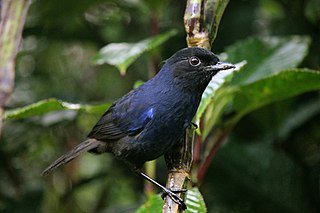 W
WThe Sri Lanka whistling thrush is a whistling thrush in the family Muscicapidae. It is a resident endemic bird in Sri Lanka.
 W
WThe Malabar trogon is a species of bird in the trogon family. It is found in the forests of Sri Lanka and peninsular India. In India it is mainly found in the Western Ghats, hill forests of central India and in parts of the Eastern Ghats. They are insectivorous and although not migratory, may move seasonally in response to rain in hill forest regions. Like in other trogons, males and females vary in plumage. The birds utter low guttural calls that can be heard only at close quarters and the birds perch still on a branch under the forest canopy, often facing away from the viewer making them easy to miss despite their colourful plumage.
 W
WThe Sri Lanka woodshrike is a species of bird in the family Vangidae. It is found on Sri Lanka. It is sometimes considered a subspecies of the common woodshrike.
 W
WThe yellow-eared bulbul is a species of songbird in the bulbul family of passerine birds. It is an endemic resident breeder in the highlands of Sri Lanka. The common name is also used as an alternate name for the yellow-throated bulbul.
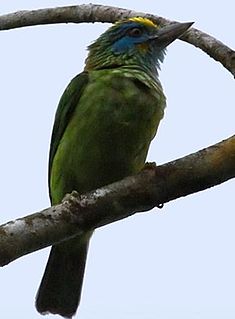 W
WThe yellow-fronted barbet is an Asian barbet, which is an endemic resident breeder in Sri Lanka, where it inhabits subtropical and tropical moist forests, wetlands, plantations and rural gardens up to an altitude of 2,000 m (6,600 ft). It has green plumage with a yellow crown and blue patches below the eyes, on the throat and the chin. It is 21–22 cm (8.3–8.7 in) long and weighs 57–60 g (2.0–2.1 oz). It feeds on berries, fruits and occasionally insects. It nests in a tree hole, where it lays 2-3 eggs.